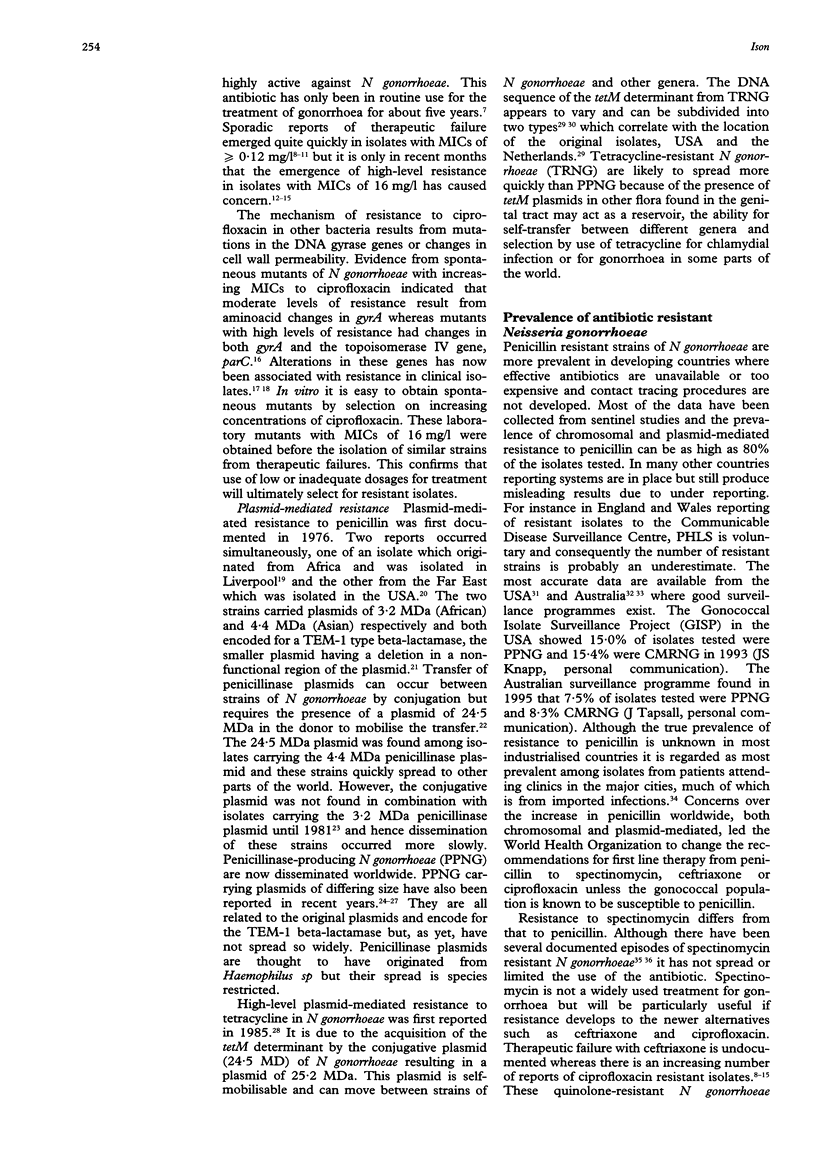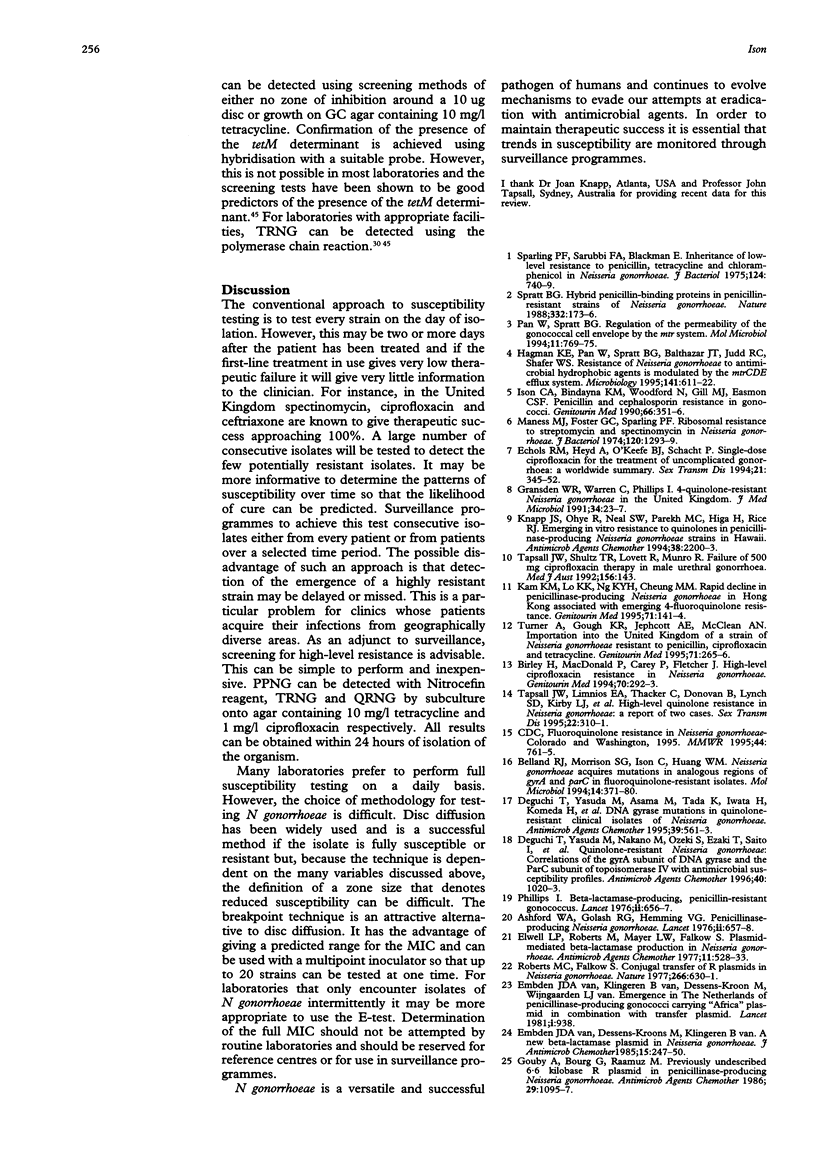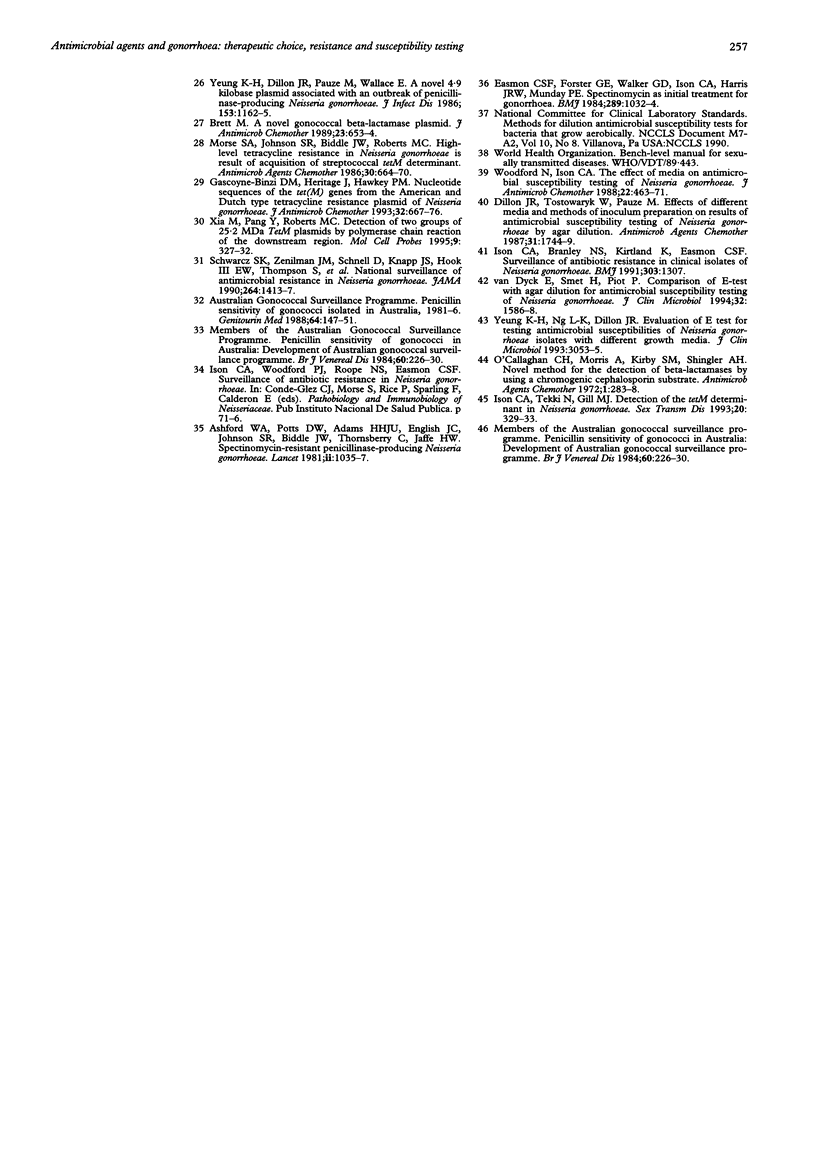Abstract
INTRODUCTION: Neisseria gonorrhoeae, the causative agent of gonorrhoea is a particularly well adapted pathogen that has continued to evolve mechanisms to evade treatment with antimicrobial agents. THERAPEUTIC CHOICE: The choice of antibiotic for use in the first-line treatment of gonorrhoea should be made with knowledge of the susceptibility of the isolates of N gonorrhoeae to be encountered. RESISTANCE: High-level resistance to penicillin and tetracycline in N gonorrhoeae is plasmid-mediated and a major therapeutic problem. Penicillinase-producing N gonorrhoeae, first described in 1976, have now spread worldwide and tetracycline-resistant N gonorrhoeae, described in 1985, are becoming increasingly prevalent. Chromosomal resistance to penicillin is low-level and affects a range of antibiotics. High-level resistance to spectinomycin has been sporadic and has not limited its use whereas the emergence of resistance to ciprofloxacin will have a significant impact on its use for gonorrhoea. SUSCEPTIBILITY TESTING: A variety of methods are available including disc diffusion, breakpoint agar dilution technique, E-test and determination of the minimum inhibitory concentration (MIC). The choice of methodology will depend on the number and type of isolates and the facilities available for testing. DISCUSSION: Surveillance programmes to monitor levels of antibiotic resistant isolates are essential to ensure therapeutic success.
Full text
PDF




Selected References
These references are in PubMed. This may not be the complete list of references from this article.
- Ashford W. A., Golash R. G., Hemming V. G. Penicillinase-producing Neisseria gonorrhoeae. Lancet. 1976 Sep 25;2(7987):657–658. doi: 10.1016/s0140-6736(76)92467-3. [DOI] [PubMed] [Google Scholar]
- Ashford W. A., Potts D. W., Adams H. J., English J. C., Johnson S. R., Biddle J. W., Thornsberry C., Jaffe H. W. Spectinomycin-resistant penicillinase-producing Neisseria gonorrhoeae. Lancet. 1981 Nov 7;2(8254):1035–1037. doi: 10.1016/s0140-6736(81)91227-7. [DOI] [PubMed] [Google Scholar]
- Belland R. J., Morrison S. G., Ison C., Huang W. M. Neisseria gonorrhoeae acquires mutations in analogous regions of gyrA and parC in fluoroquinolone-resistant isolates. Mol Microbiol. 1994 Oct;14(2):371–380. doi: 10.1111/j.1365-2958.1994.tb01297.x. [DOI] [PubMed] [Google Scholar]
- Birley H., McDonald P., Carey P., Fletcher J. High level ciprofloxacin resistance in Neisseria gonorrhoeae. Genitourin Med. 1994 Aug;70(4):292–293. doi: 10.1136/sti.70.4.292. [DOI] [PMC free article] [PubMed] [Google Scholar]
- Brett M. A novel gonococcal beta-lactamase plasmid. J Antimicrob Chemother. 1989 Apr;23(4):653–654. doi: 10.1093/jac/23.4.653. [DOI] [PubMed] [Google Scholar]
- Deguchi T., Yasuda M., Asano M., Tada K., Iwata H., Komeda H., Ezaki T., Saito I., Kawada Y. DNA gyrase mutations in quinolone-resistant clinical isolates of Neisseria gonorrhoeae. Antimicrob Agents Chemother. 1995 Feb;39(2):561–563. doi: 10.1128/aac.39.2.561. [DOI] [PMC free article] [PubMed] [Google Scholar]
- Deguchi T., Yasuda M., Nakano M., Ozeki S., Ezaki T., Saito I., Kawada Y. Quinolone-resistant Neisseria gonorrhoeae: correlation of alterations in the GyrA subunit of DNA gyrase and the ParC subunit of topoisomerase IV with antimicrobial susceptibility profiles. Antimicrob Agents Chemother. 1996 Apr;40(4):1020–1023. doi: 10.1128/aac.40.4.1020. [DOI] [PMC free article] [PubMed] [Google Scholar]
- Dillon J. A., Tostowaryk W., Pauzé M. Effects of different media and methods of inoculum preparation on results of antimicrobial susceptibility testing of Neisseria gonorrhoeae by agar dilution. Antimicrob Agents Chemother. 1987 Nov;31(11):1744–1749. doi: 10.1128/aac.31.11.1744. [DOI] [PMC free article] [PubMed] [Google Scholar]
- Easmon C. S., Forster G. E., Walker G. D., Ison C. A., Harris J. R., Munday P. E. Spectinomycin as initial treatment for gonorrhoea. Br Med J (Clin Res Ed) 1984 Oct 20;289(6451):1032–1034. doi: 10.1136/bmj.289.6451.1032. [DOI] [PMC free article] [PubMed] [Google Scholar]
- Echols R. M., Heyd A., O'Keeffe B. J., Schacht P. Single-dose ciprofloxacin for the treatment of uncomplicated gonorrhea: a worldwide summary. Sex Transm Dis. 1994 Nov-Dec;21(6):345–352. doi: 10.1097/00007435-199411000-00009. [DOI] [PubMed] [Google Scholar]
- Elwell L. P., Roberts M., Mayer L. W., Falkow S. Plasmid-mediated beta-lactamase production in Neisseria gonorrhoeae. Antimicrob Agents Chemother. 1977 Mar;11(3):528–533. doi: 10.1128/aac.11.3.528. [DOI] [PMC free article] [PubMed] [Google Scholar]
- Gascoyne-Binzi D. M., Heritage J., Hawkey P. M. Nucleotide sequences of the tet(M) genes from the American and Dutch type tetracycline resistance plasmids of Neisseria gonorrhoeae. J Antimicrob Chemother. 1993 Nov;32(5):667–676. doi: 10.1093/jac/32.5.667. [DOI] [PubMed] [Google Scholar]
- Gouby A., Bourg G., Ramuz M. Previously undescribed 6.6-kilobase R plasmid in penicillinase-producing Neisseria gonorrhoeae. Antimicrob Agents Chemother. 1986 Jun;29(6):1095–1097. doi: 10.1128/aac.29.6.1095. [DOI] [PMC free article] [PubMed] [Google Scholar]
- Gransden W. R., Warren C., Phillips I. 4-Quinolone-resistant Neisseria gonorrhoeae in the United Kingdom. J Med Microbiol. 1991 Jan;34(1):23–27. doi: 10.1099/00222615-34-1-23. [DOI] [PubMed] [Google Scholar]
- Hagman K. E., Pan W., Spratt B. G., Balthazar J. T., Judd R. C., Shafer W. M. Resistance of Neisseria gonorrhoeae to antimicrobial hydrophobic agents is modulated by the mtrRCDE efflux system. Microbiology. 1995 Mar;141(Pt 3):611–622. doi: 10.1099/13500872-141-3-611. [DOI] [PubMed] [Google Scholar]
- Ison C. A., Bindayna K. M., Woodford N., Gill M. J., Easmon C. S. Penicillin and cephalosporin resistance in gonococci. Genitourin Med. 1990 Oct;66(5):351–356. doi: 10.1136/sti.66.5.351. [DOI] [PMC free article] [PubMed] [Google Scholar]
- Ison C. A., Branley N. S., Kirtland K., Easmon C. S. Surveillance of antibiotic resistance in clinical isolates of Neisseria gonorrhoeae. BMJ. 1991 Nov 23;303(6813):1307–1307. doi: 10.1136/bmj.303.6813.1307. [DOI] [PMC free article] [PubMed] [Google Scholar]
- Ison C. A., Tekki N., Gill M. J. Detection of the tetM determinant in Neisseria gonorrhoeae. Sex Transm Dis. 1993 Nov-Dec;20(6):329–333. [PubMed] [Google Scholar]
- Kam K. M., Lo K. K., Ho N. K., Cheung M. M. Rapid decline in penicillinase-producing Neisseria gonorrhoeae in Hong Kong associated with emerging 4-fluoroquinolone resistance. Genitourin Med. 1995 Jun;71(3):141–144. doi: 10.1136/sti.71.3.141. [DOI] [PMC free article] [PubMed] [Google Scholar]
- Knapp J. S., Ohye R., Neal S. W., Parekh M. C., Higa H., Rice R. J. Emerging in vitro resistance to quinolones in penicillinase-producing Neisseria gonorrhoeae strains in Hawaii. Antimicrob Agents Chemother. 1994 Sep;38(9):2200–2203. doi: 10.1128/aac.38.9.2200. [DOI] [PMC free article] [PubMed] [Google Scholar]
- Maness M. J., Foster G. C., Sparling P. F. Ribosomal resistance to streptomycin and spectinomycin in Neisseria gonorrhoeae. J Bacteriol. 1974 Dec;120(3):1293–1299. doi: 10.1128/jb.120.3.1293-1299.1974. [DOI] [PMC free article] [PubMed] [Google Scholar]
- Morse S. A., Johnson S. R., Biddle J. W., Roberts M. C. High-level tetracycline resistance in Neisseria gonorrhoeae is result of acquisition of streptococcal tetM determinant. Antimicrob Agents Chemother. 1986 Nov;30(5):664–670. doi: 10.1128/aac.30.5.664. [DOI] [PMC free article] [PubMed] [Google Scholar]
- O'Callaghan C. H., Morris A., Kirby S. M., Shingler A. H. Novel method for detection of beta-lactamases by using a chromogenic cephalosporin substrate. Antimicrob Agents Chemother. 1972 Apr;1(4):283–288. doi: 10.1128/aac.1.4.283. [DOI] [PMC free article] [PubMed] [Google Scholar]
- Pan W., Spratt B. G. Regulation of the permeability of the gonococcal cell envelope by the mtr system. Mol Microbiol. 1994 Feb;11(4):769–775. doi: 10.1111/j.1365-2958.1994.tb00354.x. [DOI] [PubMed] [Google Scholar]
- Phillips I. Beta-lactamase-producing, penicillin-resistant gonococcus. Lancet. 1976 Sep 25;2(7987):656–657. doi: 10.1016/s0140-6736(76)92466-1. [DOI] [PubMed] [Google Scholar]
- Roberts M., Falkow S. Conjugal transfer of R plasmids in Neisseria gonorrhoeae. Nature. 1977 Apr 14;266(5603):630–631. doi: 10.1038/266630a0. [DOI] [PubMed] [Google Scholar]
- Schwarcz S. K., Zenilman J. M., Schnell D., Knapp J. S., Hook E. W., 3rd, Thompson S., Judson F. N., Holmes K. K. National surveillance of antimicrobial resistance in Neisseria gonorrhoeae. The Gonococcal Isolate Surveillance Project. JAMA. 1990 Sep 19;264(11):1413–1417. [PubMed] [Google Scholar]
- Sparling P. F., Sarubbi F. A., Jr, Blackman E. Inheritance of low-level resistance to penicillin, tetracycline, and chloramphenicol in Neisseria gonorrhoeae. J Bacteriol. 1975 Nov;124(2):740–749. doi: 10.1128/jb.124.2.740-749.1975. [DOI] [PMC free article] [PubMed] [Google Scholar]
- Spratt B. G. Hybrid penicillin-binding proteins in penicillin-resistant strains of Neisseria gonorrhoeae. Nature. 1988 Mar 10;332(6160):173–176. doi: 10.1038/332173a0. [DOI] [PubMed] [Google Scholar]
- Tapsall J. W., Limnios E. A., Thacker C., Donovan B., Lynch S. D., Kirby L. J., Wise K. A., Carmody C. J. High-level quinolone resistance in Neisseria gonorrhoeae: a report of two cases. Sex Transm Dis. 1995 Sep-Oct;22(5):310–311. doi: 10.1097/00007435-199509000-00007. [DOI] [PubMed] [Google Scholar]
- Tapsall J. W., Shultz T. R., Lovett R., Munro R. Failure of 500 mg ciprofloxacin therapy in male urethral gonorrhoea. Med J Aust. 1992 Jan 20;156(2):143–143. doi: 10.5694/j.1326-5377.1992.tb126457.x. [DOI] [PubMed] [Google Scholar]
- Turner A., Gough K. R., Jephcott A. E., McClean A. N. Importation into the UK of a strain of Neisseria gonorrhoeae resistant to penicillin, ciprofloxacin and tetracycline. Genitourin Med. 1995 Aug;71(4):265–266. doi: 10.1136/sti.71.4.265-a. [DOI] [PMC free article] [PubMed] [Google Scholar]
- Van Dyck E., Smet H., Piot P. Comparison of E test with agar dilution for antimicrobial susceptibility testing of Neisseria gonorrhoeae. J Clin Microbiol. 1994 Jun;32(6):1586–1588. doi: 10.1128/jcm.32.6.1586-1588.1994. [DOI] [PMC free article] [PubMed] [Google Scholar]
- Woodford N., Ison C. A. The effect of media on antimicrobial susceptibility testing of Neisseria gonorrhoeae. J Antimicrob Chemother. 1988 Oct;22(4):463–471. doi: 10.1093/jac/22.4.463. [DOI] [PubMed] [Google Scholar]
- Xia M., Pang Y., Roberts M. C. Detection of two groups of 25.2 MDa Tet M plasmids by polymerase chain reaction of the downstream region. Mol Cell Probes. 1995 Oct;9(5):327–332. doi: 10.1016/s0890-8508(95)91620-2. [DOI] [PubMed] [Google Scholar]
- Yeung K. H., Dillon J. R., Pauzé M., Wallace E. A novel 4.9-kilobase plasmid associated with an outbreak of penicillinase-producing Neisseria gonorrhoeae. J Infect Dis. 1986 Jun;153(6):1162–1165. doi: 10.1093/infdis/153.6.1162. [DOI] [PubMed] [Google Scholar]
- Yeung K. H., Ng L. K., Dillon J. A. Evaluation of Etest for testing antimicrobial susceptibilities of Neisseria gonorrhoeae isolates with different growth media. J Clin Microbiol. 1993 Nov;31(11):3053–3055. doi: 10.1128/jcm.31.11.3053-3055.1993. [DOI] [PMC free article] [PubMed] [Google Scholar]
- van Embden J. D., van Klingeren B., Dessens-Kroon M., van Wijngaarden L. J. Emergence in the Netherlands of penicillinase-producing gonococci carrying "Africa" plasmid in combination with transfer plasmid. Lancet. 1981 Apr 25;1(8226):938–938. doi: 10.1016/s0140-6736(81)91630-5. [DOI] [PubMed] [Google Scholar]


